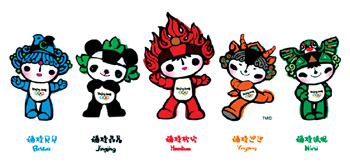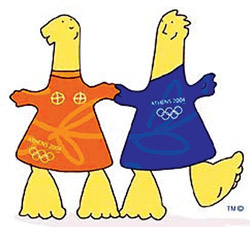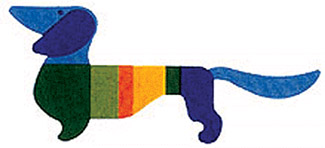How symbolic are Olympic mascots?
Olympic mascots
When it comes to special occasions, using certain symbols of various
forms has become a tradition. These symbols can be in the form of colour
themes, music, logos and so on. The concept of ‘mascots’ has been in the
field of sports for a long time and in every major sports event, some
sort of character can be seen as the mascot.
|

The Chinese mascots from left Beibei, Jingjing , Huanhuan ,
Yingying and Nini |
Similarly, the Olympics Games too has a mascot each time it’s held.
Now that the Olympics have drawn really close, let’s look at the usage
of mascots in Olympic events and who the mascots in the 2008 Olympics
are.
The big picture
Mascots have been used in Winter Olympics since 1968, held in
Grenoble, France and Summer Olympics since the 1972 Munich Olympic
Games. In simple terms, a mascot is some kind of a unique character used
to bring a form of identity to the event. This can be a cartoon
character, an endemic creature or even a super hero.
But, the real idea behind a mascot is far broader than merely having
it as a form of identity and making the event colourful. A mascot is
expected to show up the Olympic spirit, communicate the concepts of each
Olympic Games, promote the history and culture of the host city in
addition to creating a festive atmosphere for the Games.
Due to its nature, it becomes a successful way to communicate the
Olympic spirit to the general public, specially children and the youth.
Whatever shapes they have, they fundamentally share a creative basis,
that is, the mascots must be able to convey the
|

Athena and Phevos who were the mascots of the 2004 Olympics in
Athens |
theme of the Olympic
Games, display the unique geographical features, history and culture
distinctive to the host city.
These mascots are given cute names to make them more attractive to
specific age groups, and indirectly it brings in a sense of serenity and
harmony to the event.
Some popular mascots
The first ever mascot used in the Munich Olympics in 1972 was named
‘Waldi’ and it was a dachshund. A dachshund is a very sweet kind of dog
which would make a good pet. But, it also possesses qualities which are
essential to an athlete such as resistance, firmness and agility.
These are among the reasons why he was chosen to be the mascot. He
was dressed in pastel colours to express the cheerfulness of the Olympic
festival. Until 2000, single mascots were used, but in the Sydney
Olympic Games in 2000, three mascots were used.
They were named Ollie, Syd and Millie, three native Australian
animals chosen to represent earth, air and water. ‘Olly’, a kookaburra,
symbolised the Olympic spirit of generosity and universal generosity.
|

Ollie, Syd and Millie who were used at the Sydney Olympic Games
in 2000 |
‘Syd’, a platypus, represented the environment and captured the
energy of Australia and its people. ‘Millie’, was an echidna who was
supposed to be the techno-whiz, with all the facts and figures at her
fingertips,and was used to symbolise the millennium.
The 2004 Olympics in Athens, Greece also used two jovial looking
mascots named Athena and Phevos. They were based on dolls, found at
archaeological sites in Greece which date back thousands of years. Greek
mythology had it that Phevos and Athena are brother and sister, who were
named after the two Greek gods Phevos, the god of light and music, and
Athena, goddess of wisdom.
Mascots of 2008 Olympics
The mascots of the 2008 Olympics have added another dimension to the
multi-mascot tradition, by having five mascots. This set of mascots
which has been named ‘Fuwa’, has a deep meaning behind the design.
At a glance, it shows the playful qualities of five friends which
appeal to the children of the world. In addition, they also embody the
natural characteristics of four of China’s most popular animals - the
fish, the panda, the Tibetan antelope, the swallow, and also the Olympic
flame.
|

The first mascot, Waldi |
The Fuwa has been named in a traditional way of expressing affection
for children in China. ‘Beibei’ is the Fish, ‘Jingjing’ is the Panda,
‘Huanhuan’ is the Olympic Flame, ‘Yingying’ is the Tibetan Antelope and
‘Nini’ is the Swallow.
When you put their names together, it says ‘Bei Jing Huan Ying Ni’
which means ‘Welcome to Beijing,’ offering a warm invitation that
reflects the mission of Fuwa as young ambassadors for the Olympic Games.
When looking closely at the headpieces of the Fuwa, it can be seen
that the five elements of nature - sea, forest, fire, earth and sky are
represented, adhering to the traditional folk art. We will bring
particulars of each mascot in detail starting from our next edition.
- Aravinda Dassanayake
|
